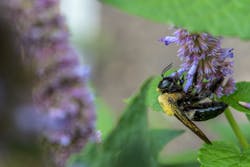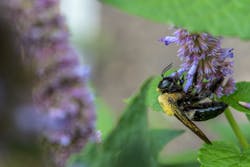June is National Pollinators Month — the time of year when we celebrate the integral role bees, butterflies and other pollinator species play in producing a bountiful supply of fruits, nuts and vegetables around the world. Pollinators aren’t just important; they’re essential. Without them, approximately 33% of our global food supply would disappear. What’s scary is that dwindling populations of certain pollinator species have the potential to turn that nightmare into a reality.
Utility companies may be surprised to learn that they have the power to restore pollinator populations to healthy levels. And perhaps more notably, they can protect utility infrastructure and their bottom line in the process.
How is this possible?
Approximately 200,000 transmission right-of-way (ROW) corridors stretch across the country, and utility companies have traditionally used mechanized mowing strategies to keep these rights-of-way clear of incompatible trees and brush species that pose a threat of interfering with utility infrastructure.
While effective in the short-term, this nonselective approach to vegetation management decimates plant communities that could be otherwise composed of beneficial grasses and forbs, which not only represent biodiverse habitat for pollinator species, but also form a natural barrier against the reestablishment of tall-growing trees and woody plants.
What can vegetation managers do differently?
Mechanized mowing is still a reliable strategy for vegetation managers — it just shouldn’t be used exclusively to support ROW management programs. Instead, industry practitioners are encouraged to follow mechanized mowing with selective herbicide applications that effectively target incompatible vegetation without causing harm to desirable plant species. This strategy aligns with an Integrated Vegetation Management (IVM) approach.
With the help of funding partners, including Asplundh Tree Expert, Corteva Agriscience, FirstEnergy Corporation, PECO Energy Company and TREE Fund, environmental ROW research studies conducted by the State Game Lands 33 (SGL 33) research project in central Pennsylvania also have revealed the ecological benefits of using IVM-based strategies throughout utility ROW corridors. In fact, a 2022 report shared by SGL 33 researchers with Penn State University (PSU) showed that plots treated with hand-cutting and mowing practices featured higher incompatible stem densities than herbicide-treated plots three years after treatment.
Why is this noteworthy? For one, higher stem counts require more maintenance. And more maintenance requires more budget — something that’s hard to come by for most vegetation management programs. Moreover, the presence of incompatible woody plants impedes the development of native plants that otherwise provide biodiverse habitat for pollinators and a variety of other wildlife species.
The following findings from the Floral and Faunal Research Report from SGL 33 researchers with PSU further illuminate the discrepancy between IVM and mowing-based strategies in terms of their impact on pollinator species:
- Hand-cutting and mowing plots featured a lower abundance of bees than most herbicide-treated plots.
- Herbicide-treated plots yielded higher levels of bee taxa richness.
- While bee abundance increased each year for most herbicide-treated plots, mechanical mowing and hand-cutting plots yielded significantly lower levels of abundance and taxa richness across all three years of study.
These findings present utility companies and their vegetation management partners with a win-win-win opportunity. By employing IVM strategies to selectively control incompatible trees and brush species after mowing treatments are complete, utility vegetation managers can achieve long-term results that deliver three noteworthy benefits:
1. Fewer maintenance requirements
2. Lower maintenance input costs
3. Positive impact on biodiversity
“I can build a long-term vegetation management plan that covers my whole system using IVM,” said Lewis Payne, ROW environmental manager, New York Power Authority (NYPA). “Once everything is set up properly, my costs are going to come down over time and the amount of herbicide I apply per acre is going to be reduced as well. If you start mowing more often, noncompatible plants will come back in full force and you’ve got to mow more frequently, which will bring your costs back up.”
Having employed IVM strategies for years to reduce maintenance costs and promote habitat development for pollinators along transmission line corridors, NYPA implemented a statewide pollinator protection initiative in 2019 to conserve and expand wild native species that pollinate local crops.
“With mowing, it’s quite likely that you’ll negatively impact biodiversity,” Payne said. “You’re going to destroy nectar resources for the pollinators and nesting habitat areas for songbirds. Mowing also opens up ground cover, which causes amphibians and reptiles to not like it out here. From an environmental sustainability standpoint, you really need to go with IVM over mowing exclusively.”
Other utilities have taken action by implementing IVM-based strategies in recent years as well. After representatives with the state of Oklahoma discovered frosted elfin butterflies (Callophrys irus) among wild indigo (Baptisia) on a solar farm last year, Oklahoma Gas & Electric (OG&E) used herbicide applications to remove incompatible vegetation before planting more wild indigo to develop additional habitat for the endangered species.
“After finding a new colony that nobody knew existed, we disturbed the environment the least amount possible,” said Shawn Huff, supervisor, vegetation management, OG&E. “The frosted elfin butterfly benefited from that greatly, and it solidified with our environmental group that we’re approaching vegetation management the right way.”
To learn more about IVM programs and the environmental benefits they provide to utility companies and their vegetation management partners, contact your local vegetation management specialist or visit HabitatWithHerbicides.com.
™ ® Trademarks of Corteva Agriscience and its affiliated companies.
Sponsored By:



